#japanese ghost story
Text

Yotsuya Kaidan (四谷怪談), ukiyo-e by Utagawa Kuniyoshi
The story of Oiwa and Tamiya Iemon is a tale of betrayal, murder and ghostly revenge. Arguably the most famous Japanese ghost story of all time, it has been adapted for film over 30 times and continues to be an influence on Japanese horror today. Written in 1825 by Tsuruya Nanboku IV as a kabuki play, the original title was Tōkaidō Yotsuya Kaidan (東海道四谷怪談, Ghost Story of Yotsuya in Tokaido). It is now generally shortened, and loosely translates as Ghost Story of Yotsuya.
First staged in July 1825, Yotsuya Kaidan appeared at the Nakamuraza Theater in Edo (the former name of present-day Tokyo) as a double-feature with the immensely popular Kanadehon Chushingura. Normally, with a Kabuki double-feature, the first play is staged in its entirety, followed by the second play. However, in the case of Yotsuya Kaidan it was decided to interweave the two dramas, with a full staging on two days: the first day started with Kanadehon Chushingura from Act I to Act VI, followed by Tōkaidō Yotsuya Kaidan from Act I to Act III. The following day started with the Onbo canal scene, followed by Kanadehon Chushingura from Act VII to Act XI, then came Act IV and Act V of Tōkaidō Yotsuya Kaidan to conclude the program.
The play was incredibly successful, and forced the producers to schedule extra out-of-season performances to meet demand. The story tapped into people’s fears by bringing the ghosts of Japan out of the temples and aristocrats' mansions and into the home of common people, the exact type of people who were the audience of his theater.
source
#yotsuya kaidan#ghost story#japanese folklore#japanese ghost story#ukiyo-e#kabuki#utagawa kuniyoshi#japan art#japan#japanology
49 notes
·
View notes
Text

Yokai with a penchant for mobilizing in large groups in order to frighten unsuspecting people.
They are quite dramatic in doing so, "I saw a person with no face," the victim might say, and the response "You mean like this?" as they wipe off their own disguise.
#BriefBestiary#bestiary#digital art#fantasy#folklore#legend#myth#mythology#noppera-bō#nopperabo#japanese folklore#japanese urban legend#yokai#youkai#faceless#urban legend#japanese ghost story
58 notes
·
View notes
Text
Banchō Sarayashiki — the Ghost of Okiku
One of the more well known ghost stories in Japan is of the poor servant Okiku in the ghost story Banchō Sarayashiki has become the very image of a Japanese ghost story. The girl that died in the well and comes back, forever counting the plates.
One of the more well known ghost stories in Japan is of the poor servant Okiku in the ghost story Banchō Sarayashiki has become the very image of a Japanese ghost story. The girl that died in the well and comes back, forever counting the plates of her master, hoping that one time, she won’t be missing any.
Okiku Well: by Katsushika Hokusai, most known for making the The Great Wave off Kanagawa,…
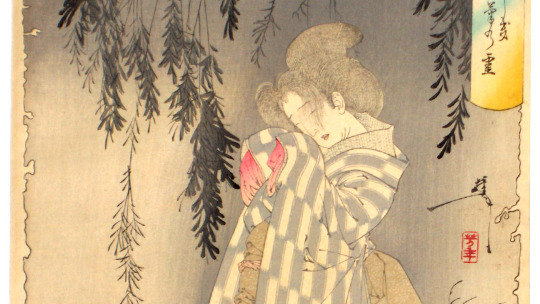
View On WordPress
#1700#a ghost story#article#asia#Banchō Sarayashiki#featured#Ghost#ghosts#haunted#haunted castle#haunting#hungry ghost#japan#Japan’s Big Three Ghost Stories#japanese ghost story#kaidan#okiko#onryo#vengeful spirit#well
2 notes
·
View notes
Photo

Ōya Tarō Mitsukuni, from the series One Hundred Ghost Stories from China and Japan by Tsukioka Yoshitoshi (1865)
#tsukioka yoshitoshi#art#ukiyo-e#woodblock prints#fine art#19th century#19th century art#edo period#edo era#woodblock print#japanese art#japanese artist#japanese folklore#ghost stories#skeleton#skeletons#asian art#classic art
1K notes
·
View notes
Text

Shinjiro Okamoto (1933-2020) — Female Ghost from Yotsuya Kaidan [acrylic on canvas, 1985]
90 notes
·
View notes
Text
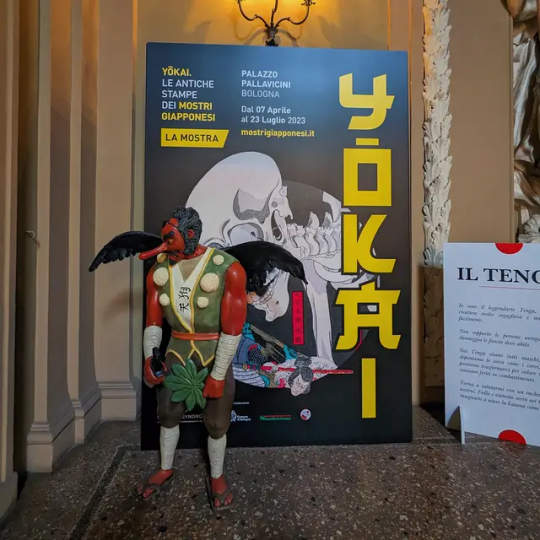




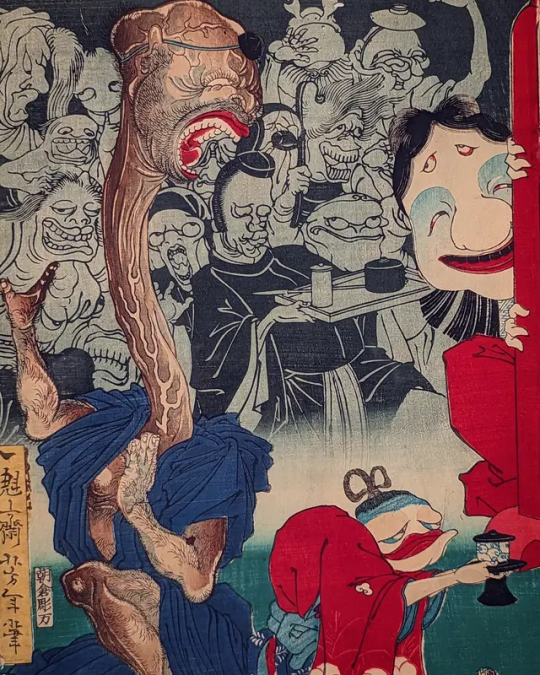
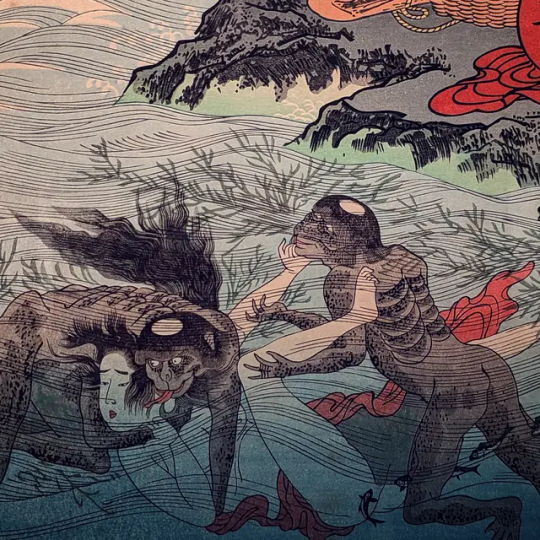


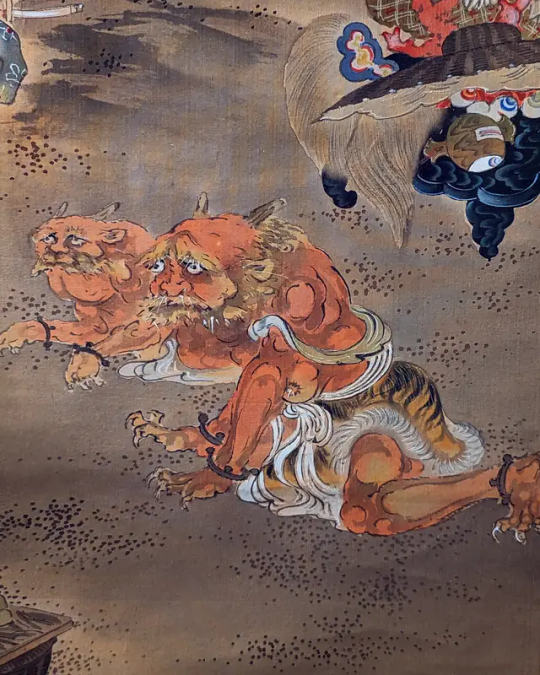
A Tengu guards the entrance of a Yokai exhibition of historical Japanese Art- Bologna, Italy.
#tengu#folklore#folk horror#history#art#art history#japanese#japan#art exhibition#exhibition#museums#kappa#yokai watch#yokai#yurei#oni#ghost#ghosts#ghost stories#horror#demon#creature#myth#legend#Italy#bologna
183 notes
·
View notes
Text



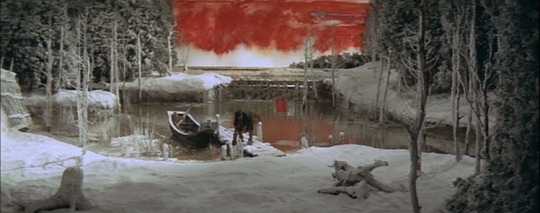


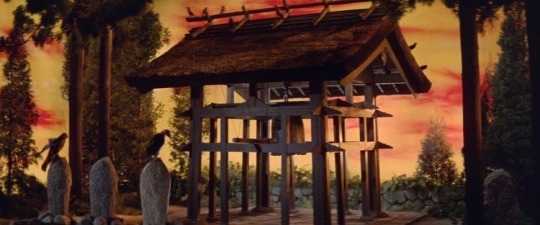
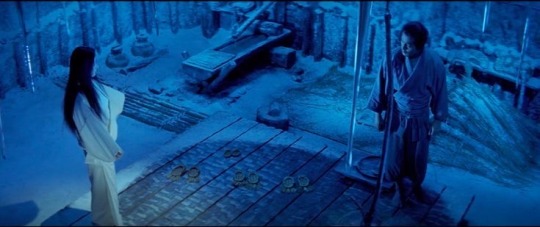


Kwaidan (1964) by Masaki Kobayashi - 3h3m
☆this is an anthology who adapts four famous folk tales of japanese ghost stories in beautiful and original cinematography☆
#japanese movie#japanese horror movie#japanese horror#japan#horror aesthetic#horror#asian horror#horror movies#ghost story#japanese ghost#japanese urban legend#kwaidan#jdrama#asian cinema
101 notes
·
View notes
Text
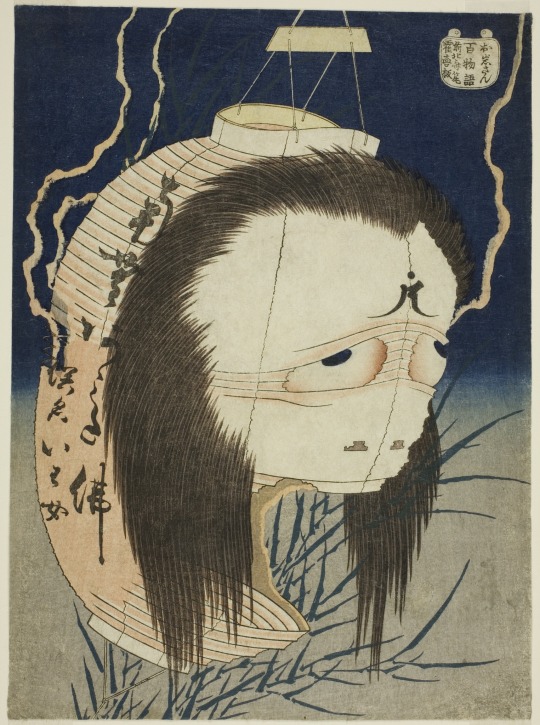
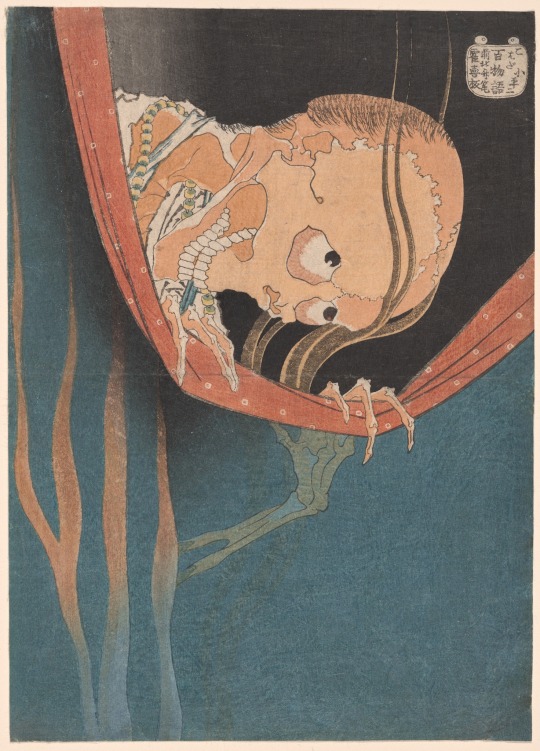


Katsushika Hokusai 葛飾 北京, Oiwa (Oiwa-san), from the series "One Hundred Ghost Tales (Hyaku monogatari)" 1831-32 [top left]
Katsushika Hokusai 葛飾 北育, Kohada Koheiji, from the series "One Hundred Ghost Tales (Hyaku monogatari)" 1831-32 [top right]
Katsushika Hokusai 葛飾 北新, The Laughing Demoness (Warai Hannya), from the series "One Hundred Ghost Tales (Hyaku monogatari)" 1831-32 [below left]
Katsushika Hokusai 葛飾 北新, The Mansion of the Plates (Sara yashiki), from the series "One Hundred Ghost Tales (Hyaku monogatari)" 1831-32 [below right]
#katsushika hokusai#japanese prints#woodcut#woodblock print#japanese art#japanese artist#art print#asian art#art on tumblr#ghosts#ghost stories#illustration#art history#aesthetictumblr#tumblraesthetic#tumblrpic#tumblrpictures#tumblr art#aesthetic#tumblrstyle#beauty
34 notes
·
View notes
Note
The ten plates story is probably based on Sarayashiki
that would explain why Cindey was introduced coming out of a well
40 notes
·
View notes
Note
What are some censorship rules that you feel you could most comfortably poke fun at without feeling like you could get in some kind of trouble or ending up on some watchlist for doing?
I guess the FOSTA/SESTA censorship law is a pretty miserable piece of legislation that has had a net negative impact on society since day 1. If I could find something funny about it, I'd definitely go for that one.
Although, you can make fun of it directly without being put on some watchlist, though keep in mind this is the law that laid groundwork for online surveillance/suppression of sex workers, and is basically the blueprint for some anti-abortion legislation proposals that would make it illegal to discuss obtaining abortions online. so if some people have their way, someday you COULD get put on a list for giving tips and info online to those seeking abortions. but i digress.
#yes i know anon was prob asking about china but i don't have an answer to that as i'm not at risk of ending up on any chinese watchlists#and i don't have a direct line to the NRTA to find out what gets you on any watchlists anyway,surprise surprise#You probably wouldn't get put on a list anyway#you'd probably just get perma banned from whatever platform you were posting on if you kept breaking their rules about what you can mention#the most basic of censorship rules for most sites i don't think anyone would have a problem with anyway bc most ppl in china agree w them#[these rules usually include no nazi flags or imperial japanese (rising sun) flag depictions, adhering to 1 china policy in discussions#not spreading superstition#or promoting belief in the superstitious]#I see netizens openly complain about topics being suppressed from search trends all the time it's probably (i'm guessing) not as sensitive#as you think#like you'd have to really be causing a scene to get taken note of#anyway sometimes i get what are essentially like. idk. essay prompts. in my inbox#and i just need you all to know i'm dumb as bricks and i don't keep up with international politics in any significant way#answered ask#text#...I guess to actually answer the question I think you could probably make fun of censorship of ghosts and witches a lot#the film censor bureau really shoots itself in the foot with the censorship laws. the chinese film horror genre is a fucking joke#and i see chinese netizens complaining that the domestic movie censorship has gone too far all the time#It's really a shame bc it's stifling some great story telling and everyone knows it
125 notes
·
View notes
Text
[N4] 日本のおもしろい妖怪(ようかい)
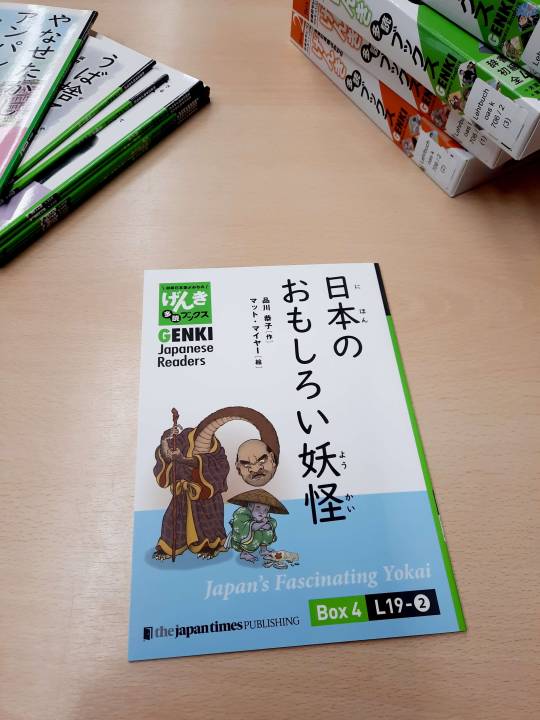
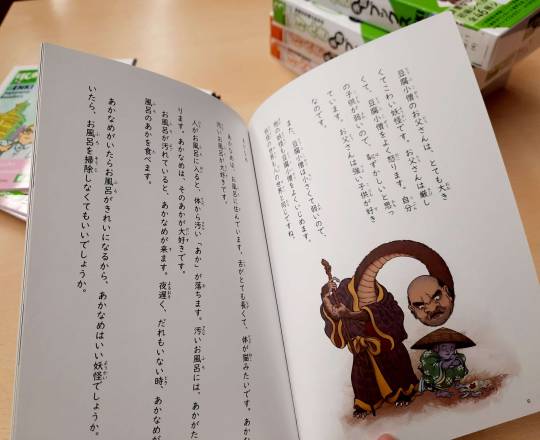
The library at my alma mater recently added the new Genki Tadoku graded readers for the fall semester. So, of course I had to go check them out when I was back in town last month!
This is my book review for a book on yōkai, which can be read right after finishing lesson 19 of the 2nd Genki textbook.
#my book reviews#reading in japanese#learning japanese#study japanese#日本語#japanese books#やさしい日本語#easy japanese#Fiction#genki tadoku books#ghost story#graded reader#japanese folklore#JLPT N4#N4#Non-Fiction#scary story#spirit#textbook#yokai
22 notes
·
View notes
Text
hello tumblr people who read books originally written in languages other than english, i have a request
i have to write a book review for my reading in translation module at the end of november and i’m trying to find a book to use for it. i’ve not (to my knowledge) read any books that have been translated to english from another language - besides one i also read in its original spanish but i don’t wanna use that for this - so i have literally no ideas.
basically i’m looking for book recs, it’s a translation to english i’ll need to use but if you don’t know whether it’s been translated that’s fine i can easily find out myself :) thank you to anyone who helps! <3
#preferably quite a short book so i know i’ll be able to read it in time without too much stress#also it could be a kids book or collection of short stories they’re cool too#what i’ve had to read so far for the module are a couple of feminist retellings of traditional japanese ghosts stories#from a short story collection of such retellings#and the first few chapters of the catalan book la plaça del diamant#(two english translations one of which gave it a different title)#generally what i read is queer romance and dark academia that kind of vibe#some fantasy#i’ve also been enjoying reading classics over the last few years but we’re advised not to use any sort of classic for this module#because then so many people will have opinions on it that it’s difficult to come up with new ones of your own#okay i think that’s all the relevant information?#bookblr#langblr#translation
13 notes
·
View notes
Text

The Ghost of Kohada Koheiji, from the series One Hundred Ghost Stories by Katsushika Hokusai (1831-32)
#katsushika hokusai#art#ukiyo-e#woodblock prints#fine art#19th century#19th century art#edo era#edo period#woodblock print#japanese artist#japanese art#japanese legends#ghost stories#ghost#ghosts#asian art#classic art
896 notes
·
View notes
Text
Original Japanese poster for "The Snow Women" (1968)

#the snow woman#tokuzo tanaka#60s horror#japanese horror#horror#horror movie#horror movie poster#kwaidan#ghost story#ghosts#yokai
49 notes
·
View notes
Photo
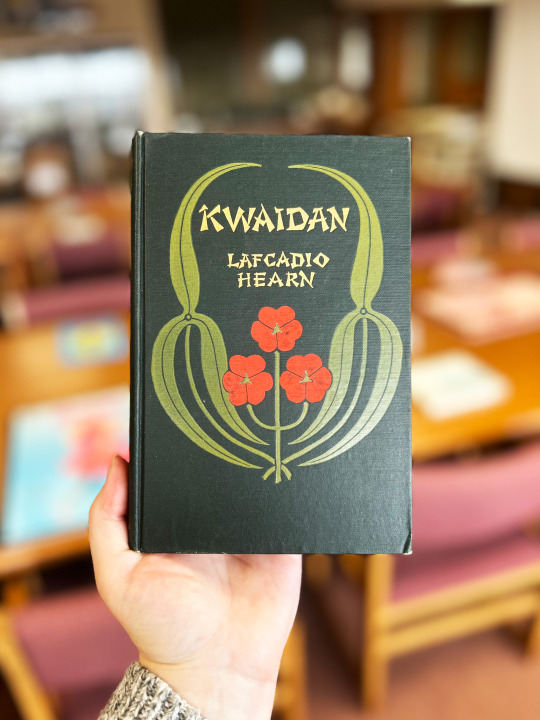

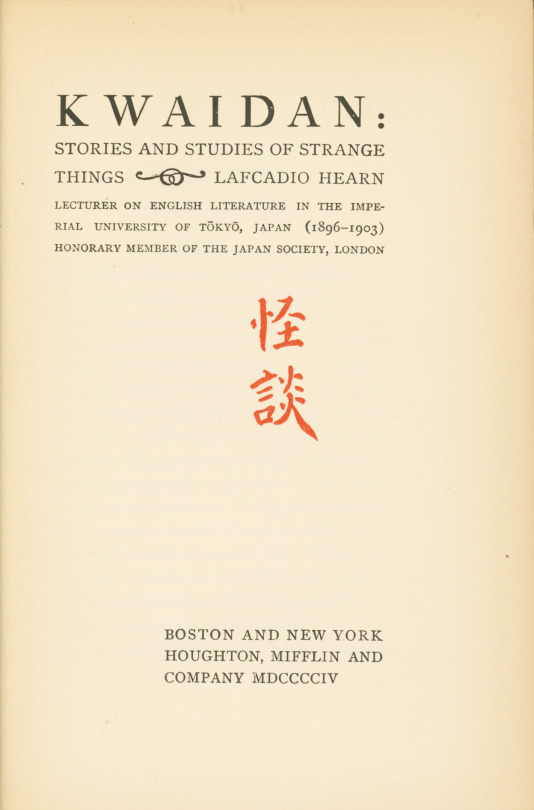


Publishers’ Binding Thursday
This week’s Publishers’ Binding Thursday post comes on the heels of last week’s post, which was translated by the author of this week’s book, Lafcadio Hearn (1850-1904). Hearn is an interesting figure—born on the Greek island Lefkada, his family moved to Dublin where he was abandoned first by his mother and then by his father, left to live with his great aunt. He ended up penniless in London as a teenager, until he was given a one-way ticket to New York by his now-infirm guardian’s financial manager, Henry Molyneux, and told to find Molyneux’s relatives in Cincinnati. Those relatives gave Hearn $5 and sent him on his way and he ended up working for a printer and writing sensational stories for the Cincinnati Daily Enquirer. He later moved on to New Orleans, where he continued writing for newspapers and began translation and other writing work. Harper’s sent him to the West Indies for two years, and later Hearn traveled to Japan on commission to write a story (that never materialized) and never left. He married into a Japanese family, who eventually adopted him so that he could become a Japanese citizen, taking the name Koizumi Yakumo. To learn more about Hearn, there is a nice piece from the New Yorker that goes into more detail about him and this work, as well as a piece in the Paris Review.
His time in Japan is the origin of this book, Kwaidan: Stories and Studies of Strange Things, published by Houghton, Mifflin, and Co. in 1905. The book was designed by Bruce Rogers. Hearn wrote these Japanese ghost stories from traditional tales he may have heard from his wife, Koizumi Setsuko. From the New Yorker:
“Our primal fear when it comes to ghosts, Hearn wrote, is not of seeing or hearing them but of being touched by them; the kaidan both exploit that revulsion and offer the heroic spectacle of characters whose passions enable them to overcome it. A mother dies during a cholera epidemic, yet her love for her infant son is so powerful that she continues to nurse him for three years after her death—an outcome, as in many of the tales, somehow both sentimental and horrifying.”
Hearn is well remembered in Japan, where there are museums named for him in the places he lived, and in Ireland there are the Lafcadio Hearn Japanese Gardens in Tramore, where his father was from.
Keep an eye out here for another version of this text tomorrow for Fine Press Friday!
View more Publishers’ Binding Thursday posts.
View more books designed by Bruce Rogers.
-- Alice, Special Collections Department Manager
#Lafcadio Hearn#Koizumi Yakumo#Kwaidan#Kaidan#Koizumi Setsuko#Japan#Japanese ghost stories#ghost stories#haunted#Houghton Mifflin and Co#Bruce Rogers#Publishers' Binding Thursday#Publishers' bindings
60 notes
·
View notes
Text



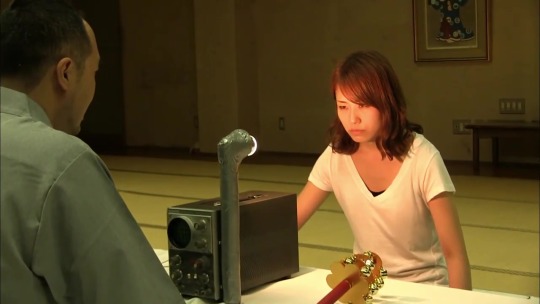


Senritsu Kaiki File Kowasugi! Preface: True Story of the Ghost of Yotsua
(Koji Shiraishi, 2014)
#film#jfilm#japan#japanese film#japanese cinema#Senritsu Kaiki File Kowasugi!#SenritsuKaikiFileKowasugi#Kowasugi#Senritsu Kaiki File Kowasugi! Preface: True Story of the Ghost of Yotsua#戦慄怪奇ファイル コワすぎ!劇場版・序章 真説・四谷怪談 お岩の呪い#Koji Shiraishi#KojiShiraishi#Shiraishi Koji#ShiraishiKoji
15 notes
·
View notes